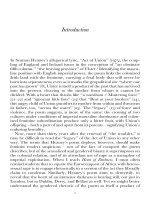0521842271 cambridge university press cultures of power in europe during the long eighteenth century jul 2007
Bạn đang xem bản rút gọn của tài liệu. Xem và tải ngay bản đầy đủ của tài liệu tại đây (2.38 MB, 400 trang )
This page intentionally left blank
Cultures of Power in Europe during the Long
Eighteenth Century
This original volume seeks to get behind the surface of political events
and to identify the forces which shaped politics and culture from 1680
to 1840 in Germany, France and Great Britain. The contributors, all
leading specialists in the field, explore critically how ‘culture’, defined
in the widest sense, was exploited during the ‘long eighteenth century’
to buttress authority in all its forms and how politics infused culture.
Individual essays explore topics ranging from the military culture of
central Europe through the political culture of Germany, France and
Great Britain, music, court intrigue and diplomatic practice, religious
conflict and political ideas, the role of the Enlightenment, to the very new
dispensations which prevailed during and after the French Revolution
and the Napoleonic watershed. The book will be essential reading for
all scholars of eighteenth-century European history.
is Wardlaw Professor of International History at the
University of St Andrews. His recent publications include The Emergence
of the Eastern Powers, 1756–1775 (2001) and The Birth of a Great Power
System, 1740–1815 (2006).
is Reader in the History of International Relations
at the University of Cambridge and Fellow of Peterhouse. His previous publications include The Impact of Napoleon: Prussian High Politics,
Foreign Policy and the Crisis of the Executive, 1797–1806 (1997) and as an
editor with Torsten Riotte, The Hanoverian Dimension in British History,
1714–1837 (2007).
Cultures of Power in
Europe during the Long
Eighteenth Century
Edited by
Hamish Scott and Brendan Simms
CAMBRIDGE UNIVERSITY PRESS
Cambridge, New York, Melbourne, Madrid, Cape Town, Singapore, São Paulo
Cambridge University Press
The Edinburgh Building, Cambridge CB2 8RU, UK
Published in the United States of America by Cambridge University Press, New York
www.cambridge.org
Information on this title: www.cambridge.org/9780521842273
© Cambridge University Press 2007
This publication is in copyright. Subject to statutory exception and to the provision of
relevant collective licensing agreements, no reproduction of any part may take place
without the written permission of Cambridge University Press.
First published in print format 2007
eBook (EBL)
ISBN-13 978-0-511-28902-6
ISBN-10 0-511-28902-2
eBook (EBL)
ISBN-13
ISBN-10
hardback
978-0-521-84227-3
hardback
0-521-84227-1
Cambridge University Press has no responsibility for the persistence or accuracy of urls
for external or third-party internet websites referred to in this publication, and does not
guarantee that any content on such websites is, or will remain, accurate or appropriate.
For Tim Blanning
Contents
Preface
List of contributors
1 Introduction: culture and power during the long
eighteenth century
.
2 When culture meets power: the Prussian coronation
of 1701
page ix
xi
1
14
3 Military culture in the Reich, c. 1680–1806
.
36
4 Diplomatic culture in old regime Europe
58
5 Early eighteenth-century Britain as a confessional state
.
86
6 ‘Ministers of Europe’: British strategic culture,
1714–1760
7 Confessional power and the power of confession:
concealing and revealing the faith in Alpine Salzburg,
1730–1734
110
133
8 The transformation of the Aufkl¨arung: from the idea of
power to the power of ideas
158
9 Culture and B¨urgerlichkeit in eighteenth-century
Germany
180
vii
viii
Contents
10 The politics of language and the languages of politics:
Latin and the vernaculars in eighteenth-century
Hungary
. . .
11 ‘Silence, respect obedience’: political culture
in Louis XV’s France
12 Joseph II, petitions and the public sphere
13 The court nobility and the origins of the French
Revolution
14 The French Revolution and the abolition of nobility
200
225
249
269
289
15 Foreign policy and political culture in later
eighteenth-century France
304
16 Power and patronage in Mozart’s La clemenza di Tito
and Die Zauberfl¨ote
325
17 Between Louis and Ludwig: from the culture of French
power to the power of German culture, c. 1789–1848
.
348
Index
369
Preface
In April 2007, Professor T. C. W. Blanning – Tim to all his friends and
now to the scholarly community as well – will celebrate his sixty-fifth
birthday, improbable as this will seem. In order to mark this occasion,
to celebrate his enormous contribution to the study of modern European history, and to convey a sense of the immense regard in which he is
universally held, it was decided to publish a volume of essays dedicated
to him and written by some of his many friends and admirers. It takes
its cue and also its starting point from Tim’s celebrated The Culture of
Power and the Power of Culture: Old Regime Europe, 1660–1789 (Oxford
University Press, 2002). Contributors were asked to extend the perspectives of that seminal book, and to explore critically how ‘culture’ (defined
in the widest sense) was exploited during the ‘long eighteenth century’
to buttress authority in all its forms and how politics infused culture.
Coherence was also sought by a decision to concentrate on the period –
the long eighteenth century – which has been the principal focus of
Tim’s own scholarship and on the areas which his work has particularly
illuminated: the German-speaking lands, France and Britain. While this,
together with the period selected for consideration, had the unfortunate
effect of excluding some friends and colleagues who would have been
obvious contributors, it was inevitable given the realities of present-day
publishing. Tim’s renowned openness to all subjects and all approaches
encouraged us to produce a volume which fully reflected the various uses
to which the concept of ‘culture’ has been put.
The essays published in this volume were first given as papers at a
highly enjoyable conference held in Cambridge in September 2005, and
were revised for publication in the light of discussions and comments at
this gathering. We are grateful to the contributors for their willingness to
revise their essays in the interests of the volume’s overall coherence and for
their remarkable ability to deliver their essays by the due date: a tribute, in
many case, to the good habits inculcated by Tim’s doctoral supervision.
The conference was funded by the German Historical Institute, London,
and we are deeply indebted to its Director, Professor Hagen Schulze, for
ix
x
Preface
this extraordinary generosity, which is only the latest example of the Institute’s remarkable support of scholarship in the British academic world. Its
Deputy, Dr Benedikt Stuchtey, very kindly attended the Cambridge conference. The Trevelyan Fund of the University of Cambridge also made
a generous grant to cover the travel expenses of the participants. At the
Press we are indebted to Bill Davies who did much to get the project off
the ground and to his successor Michael Watson who smoothed the passage to publication. Nancy Bailey has applied her electronic wizardry to
the production of a finished manuscript, while Christopher Riches made
the Index: we are grateful to them both. In the planning stages, Derek
Beales provided important advice, while Nicky Blanning furnished decisive, if for a time covert, assistance, and Tom, Lucy and Molly kept us all
enchanted. We owe most to Tim, however, both for providing the excuse
for this academic stock-taking on Blanning’s eighteenth century, and for
his scholarship and celebrated generosity, both professional and personal,
from which all the contributors have frequently benefited. Celebration of
his birthday is accompanied with our best wishes for many more years of
personal happiness and scholarly productivity.
April 2006
Contributors
is Emeritus Professor of Modern History in the
University of Cambridge, where he is a Fellow of Sidney Sussex
College. A Fellow of the British Academy, he is the author of England
and Italy, 1859–60 (London, 1961), From Castlereagh to Gladstone (London, 1969), The Risorgimento and the Unification of Italy
(London, 1971; 2nd edn, with Eugenio Biagini, 2003), Joseph II, i:
In the Shadow of Maria Theresa, 1741–1780 (Cambridge, 1987), Prosperity and Plunder: European Catholic Monasteries in the Age of Revolution,
1650–1815 (Cambridge, 2003) and Enlightenment and Reform in
Eighteenth-Century Europe (London, 2005). He is currently writing the
second volume of his life of Joseph II.
is a Fellow of Peterhouse, and British Academy Postdoctoral Fellow. He has written on various aspects of cultural, intellectual
and musical history from the eighteenth century to the present day,
and is the author of Treacherous Bonds and Laughing Fire: Politics and
Religion in Wagner’s ‘Ring’ (Aldershot and Burlington, 2006). For his
work on Wagner he was awarded the Prince Consort Prize and the
Seeley Medal. His present research concerns the relationship between
aesthetics, politics and music drama after Wagner, focusing especially
upon the writings of Adorno and the operas of Schoenberg, Berg and
the post-war avant-garde.
is Reader in Modern European History at the
University of Cambridge, where he is a Fellow of St Catharine’s College. He is the author of The Politics of Conversion: Missionary Protestantism and the Jews in Prussia, 1728–1941 (Oxford, 1995), Kaiser Wilhelm II (London, 2000) and Iron Kingdom: The Rise and Downfall of
Prussia (London, 2006). He is currently working on a transnational
study of European governmental responses to the mid-nineteenthcentury revolutions, and a narrative history of the July Crisis of
1914.
xi
xii
List of contributors
has been Professor of History at the University of
Bristol since 1986. A Fellow of the British Academy, he is the author of
The Oxford History of the French Revolution (Oxford, 1989), Venality: The
Sale of Offices in Eighteenth Century France (Oxford, 1996), Jansenism
(Basingstoke, 2000) and The French Revolution: A Very Short Introduction (Oxford, 2001). He is currently editing an Oxford History Handbook on the Ancien R´egime, and writing a book on the ‘Attack on
Nobility in the Age of Revolutions’.
. . . is Regius Professor of History at the University of
Oxford, where he is a Fellow of Oriel College. A Fellow of the British
Academy, he has published extensively on the history of the Habsburg
Monarchy and its successor states from the sixteenth century to the
twentieth, including studies of Rudolf II and His World (Oxford, 1975)
and The Making of the Habsburg Monarchy, 1550–1700 (Oxford, 1979).
Relevant recent publications include ‘Language and State-Building:
The Case of the Habsburg Monarchy’, Austrian History Yearbook 35
(2004) and some of the chapters in his Austria, Hungary, and the
Habsburgs: Essays on Central Europe, c. 1683–1867 (Oxford, 2006). His
main long-term research project is a history of modern Hungary.
is Professor of History at Emory University. His publications include The Rise of the Public in Enlightenment
Europe (Cambridge, 2001) and Absolutism and the Eighteenth-Century
Origins of Compulsory Schooling in Prussia and Austria (Cambridge,
1988). He is also editor of Cultures of Communication from Reformation to
Enlightenment: Constructing Publics in the Early Modern German Lands
(Aldershot, 2002), joint editor (with Hartmut Lehmann) of Paths of
Continuity: Central European Historiography from the 1930s to the 1950s
(Cambridge, 1994) and editor and translator (with Howard Kaminsky) of Otto Brunner, ‘Land’ and Lordship: Structures of Governance in
Medieval Austria (Philadelphia, 1992).
is Professor of Modern European History at the University of Bradford. His publications include Preserving the Monarchy:
The Comte de Vergennes, 1774–1787 (Cambridge, 1995) and The Fall
of the French Monarchy: Louis XVI, Marie Antoinette and the Baron de
Breteuil (Basingstoke, 2002). He is currently working on a study of the
constitutional monarchy in France between 1814 and 1848.
is currently Under Master (Deputy Head) at Westminster School, London. He was previously Head of History and Masterin-College at Eton College, Windsor. His publications include
‘“Favier’s Heirs”: The French Revolution and the secret du roi’,
List of contributors
xiii
Historical Journal 41 (1998) and ‘Novel Narratives, New Research:
The French Revolution after the Bicentennial’, Historical Journal 40
(1997). He is currently preparing his Cambridge Ph.D. thesis (2005)
on ‘The French Revolution and the secret du roi: Diplomatic Tradition, Foreign Policy and Political Culture in Later Eighteenth-Century
France (1756–1792)’ for publication as a monograph.
is Wardlaw Professor of International History at the
University of St Andrews. A Fellow of the British Academy, he is the
author of The Rise of the Great Powers, 1648–1815 (with Derek McKay;
Harlow, 1983), British Foreign Policy in the Age of the American Revolution (Oxford, 1990), The Emergence of the Eastern Powers, 1756–1775
(Cambridge, 2001) and The Birth of a Great Power System, 1740–1815
(Harlow, 2006). He is currently writing a study of aristocracy in Europe
c. 1400–1750.
. is Dickason Professor in the Humanities and Professor of History at Stanford University, where he has taught since
1979. He is the author and editor of several books on European
history; his most recent book is Museums in the German Art World
(Oxford, 2000). He has just completed a manuscript on ‘The Eclipse of
Violence: The Transformation of European Politics’, which traces the
changing relationship of states and war in twentieth-century Europe. A
Fellow of the American Academy of Arts and Sciences and a member
of the American Philosophical Society, he served as president of the
American Historical Association in 2005.
is Reader in the History of International Relations at
the Centre of International Studies, University of Cambridge, and a
Fellow of Peterhouse. His publications include The Impact of Napoleon:
Prussian High Politics, Foreign Policy and the Crisis of the Executive,
1797–1806 (Cambridge, 1997), The Struggle for Mastery in Germany,
1779–1850 (Basingstoke, 1998), Unfinest Hour: Britain and the Destruction of Bosnia (London, 2001) and (as editor with Torsten Riotte)
The Hanoverian Dimension in British History, 1714–1837 (Cambridge,
2007). He is currently completing a study of British foreign policy in
the eighteenth century.
is Reader in Modern History at Birkbeck College, University of London. He is the author of Politics and the Parlement of Paris
under Louis XV, 1754–1774 (Cambridge, 1995) and of Provincial Power
and Absolute Monarchy: The Estates General of Burgundy, 1661–1790
(Cambridge, 2003) and (with Barry Coward) has edited Conspiracies
and Conspiracy Theory in Early Modern Europe, 1500–1800 (Aldershot,
xiv
List of contributors
2004). He is currently writing a history of political disgrace and internal
exile in old regime France.
. is a College Lecturer in History at Queens’
College, Cambridge. He is the author of several articles on British and
European history, and a revised version of his Cambridge University
Ph.D. thesis was recently published as Britain, Hanover and the Protestant Interest, 1688–1756 (Woodbridge, 2006). He is currently writing a
biography of George II for Yale University Press.
is a Senior Lecturer in Modern European History at
the University of Manchester. During the past few years she has held
visiting appointments at the Australian National University, Harvard
University, the Universitad Pompeu Fabra in Barcelona and University College London. She is the author of Federalism and Enlightenment
in Germany, 1740–1806 (London, 2000), editor of German Federalism:
Past, Present and Future (Basingstoke, 2002) and (with Bernd Huppauf)
¨
Vernacular Modernism: Heimat, Globalization and the Built Environment
(Stanford, 2005). She is currently completing a book on ‘German
Cities and the Genesis of Modernism, 1890–1930’.
is a Fellow of Gonville and Caius College and
Senior Lecturer in German at the University of Cambridge. He is the
author of Religious Toleration and Social Change in Hamburg, 1529–1819
(Cambridge, 1985) in addition to numerous articles, reviews and contributions to handbooks and lexicons of German history and literature.
He is currently writing a history of the Holy Roman Empire 1495–
1806, for the Oxford History of Early Modern Europe.
. is G. F. Grant Professor of History at the University
of Hull. His publications include War, State and Society in W¨urttemberg,
1677–1793 (Cambridge, 1995), German Armies: War and German Politics, 1648–1806 (London, 1998), The Holy Roman Empire, 1495–1806
(Basingstoke, 1999; 2nd edn, Tokyo, 2005), Absolutism in Central
Europe (London, 2000) and From Reich to Revolution: German History, 1558–1806 (Basingstoke, 2004), and, as editor, Warfare in Europe,
1815–1914 (Aldershot, 2006) and 1848: The Year of Revolutions (Aldershot, 2006). He is currently writing a book on the Thirty Years’ War
for Penguin Press.
. is Assistant Professor of Eighteenth- and
Nineteenth-Century British and European History at Columbia University. She was a Research Fellow at Emmanuel College, Cambridge,
before moving to New York. Her publications include ‘German Fresco
List of contributors
xv
Painting and the New Houses of Parliament at Westminster, 1834–51’,
Historical Journal 47 (2004) and ‘Prince Albert, Fresco Painting, and
the New Houses of Parliament’, in J. Davis and F. Bosbach, eds., Prinz
Albert – ein Wettiner in Großbritannien/Prince Albert – a Wettin in Britain
(Munich, 2004). She is currently preparing her Cambridge doctoral
thesis (2005), on the relationship between art and taste, state and
nation in Germany and England between 1789–1858, for publication.
1
Introduction: culture and power during the
long eighteenth century
James J. Sheehan
Stanford University
In December 1774, seventeen-year-old Carl August, Prince of Saxe
Weimar, met the celebrated young author Johann Wolfgang Goethe in a
Frankfurt hotel room. The meeting was cordial, indeed the two men got
along together so splendidly that, less than a year later, Goethe accepted
the prince’s invitation to move to Weimar, where he would spend the rest
of his long and incredibly productive life.
I begin with this familiar scene – so beautifully rendered and analysed in Nicholas Boyle’s distinguished biography of the poet – because it
neatly captures several of the motifs in the complex relationship between
culture and power in the eighteenth century.1 First and most obvious is
the persistent significance of the court, whose seductive blend of artistic possibilities and political influence led Goethe to disregard his father’s
opposition and take up residence in Carl August’s small Thuringian state.
Second, there is the new significance of public culture, reflected here in
Goethe’s position as literary celebrity, which had caused a member of
the prince’s entourage to seek out the author of The Sorrows of Young
Werther and which would make Goethe such an attractive presence in
Carl August’s entourage. Both prince and poet needed one another, both
acquired prestige and a kind of power from the other’s presence. Court
and public were not just alternative sites of cultural practice, they often
worked together, each reinforcing the other.
Just behind the surface of this meeting of poet and prince, court and
public, we can see some of the difficulties involved in understanding
the relationship between eighteenth-century culture and power. Consider, for example, how difficult it is to fit Goethe into any of the usual
social categories – he remains a B¨urger among courtiers, a courtier among
B¨urger, a civil servant, a ‘favourite’ and, most of all, a citizen of the
republic of letters. Goethe’s relationship to German nationalism is no
1
Boyle, Goethe: The Poet and the Age. Vol. I. The Poetry of Desire (1749–1790) (Oxford:
Clarendon Press, 1991), pp. 194ff.
1
2
James J. Sheehan
less perplexing. He is a great national poet, someone, in Friedrich Meinecke’s phrase, who taught Germans who they were. But he was never
comfortable with national rhetoric and often contemptuous of patriotic
enthusiasts. And what about Goethe’s political views? At once attracted
and repelled by power, critical of both the old regime and its revolutionary opponents, insider and outsider, Goethe’s politics, like so much else
about him, remained elusive and unsettled. T. S. Eliot once commented
that ‘Goethe was about as unrepresentative of his age as a man of genius
can be.’2 But in one way Goethe was exemplary, and that is of the richness and complexity of the period with which the essays in this volume
are concerned.
I
The major source of inspiration for these essays is the work of T. C. W.
Blanning. Let me begin with a few words about Tim Blanning’s scholarly career, concluding with a discussion of his magisterial The Culture of
Power and the Power of Culture: Old Regime Europe, 1660–1789, which was
published by the Oxford University Press in 2002.
The first things to be noted is that Blanning is a European historian.
This was apparent in his first book on Joseph II, but it was much more
evident in the two books that established his reputation: Reform and Revolution in Mainz (published by Cambridge University Press in 1974)
and The French Revolution in Germany (published by Oxford University
Press in 1983). It is of great significance, I think, that Blanning began
with the Rhineland. This is, after all, an intensely European place, not
least because it has been the scene of so many conflicts over regional
and national identity. By studying the Rhineland Blanning was able to
approach German history from the west and French history from the
east, confronting in the process some of the central problems of each
without being the captive of either. (What French historian, for example, would have dared to begin a book entitled The French Revolutionary
Wars with the battle of Rossbach, Frederick the Great’s victory in 1757?)
Blanning has contributed to both German and French historiography,
but has never been just a ‘German’ or ‘French’ historian nor has he ever
been confined by their conventional wisdoms.
Consider, for example, the quotation with which his Mainz book
begins: ‘The contrast between Germany and Western Europe in modern
history has long been a subject of historical interpretation and research.’
2
Quoted from ibid., p. 7 in T. C. W. Blanning, The Culture of Power and the Power of Culture:
Old Regime Europe, 1660–1789 (Oxford: Oxford University Press, 2002), p. 98.
Introduction: culture and power
3
This sentence, from Hajo Holborn’s influential essay on ‘German Idealism in the Light of Social History’, takes us directly to what is immediately
recognizable as the Sonderweg, the historiographical conviction that Germany followed a ‘special path’ to modernity.3 And yet Blanning travels
this path to a destination quite different from most of its adherents: he
finds not the usual failed German modernization, but rather ‘the astonishing ability of the political and social establishment in Germany to absorb,
adapt, and even utilize progressive and potentially disruptive forces’.4 In
a number of ways, Blanning cuts against the grain of scholarly orthodoxy:
in contrast to German nationalist historians, he recognizes the value and
viability of the Holy Roman Empire (he was, in fact, among the first modern scholars to insist on the empire’s positive role as a source of order and
stability in central Europe). In contrast to Protestant historians, he does
not dismiss traditional Catholic piety or overlook the progressive elements
within the Rhenish Church; and in contrast to a variety of democratic
and Marxist historians, he did not magnify or distort the influence of the
members of the Mainz Jacobin club. His comment on the latter issue is
characteristic:
In view of this rejection of the Revolution by most of the inhabitants of the city,
the disproportionate amount of attention lavished by historians on the Clubists is
explicable only in terms of the ease with which they can be adapted to suit various
historiographical schools.5
In The French Revolution in Germany, Blanning once again tries to drive
a stake through the heart of German Jacobinism, which, vampire like,
keeps struggling to emerge from the historiographical crypt. This book,
while narrower chronologically than his study of Mainz, examines many
of the same themes for the Rhineland as a whole. Deeply researched and
vigorously written, it documents the wanton destruction of traditional
institutions, the ruthlessness of the revolution’s anti-clericalism and the
increasingly despotic face of the revolution abroad. The revolution, Blanning argues, governed the Rhineland not through the power of its ideas
or the promise of its programme, but with brute force. French rule rested
on the army: ‘without it, the revolutionary regime could not have lasted a
week’.6 Here we have that familiar figure in German historiography, ‘the
revolution from above’, imposed not by Prussian autocrats but by French
democrats. It is not a pretty picture.
3
4
5
Reform and Revolution in Mainz, p. 1. Holborn’s essay is available in Germany and Europe:
Historical Essays (Garden City, NY: Doubleday, 1970).
Blanning, Reform and Revolution in Mainz, p. 3.
6 The French Revolution in Germany, p. 206.
Ibid., p. 295.
4
James J. Sheehan
The next phase of Blanning’s scholarship was directly about the French
Revolution and the Revolutionary Wars. In part this was a natural extension of his work on the Rhineland, in part he may have been irresistibly
drawn into the historiographical vortex created by the bicentennial celebrations of 1789. Blanning wrote three books on various aspects of the
revolution and edited one of the best collections of articles inspired by
the bicentennial.7 His books on the Revolutionary Wars are beautifully
done, examples of his range as a scholar and his versatility as a writer. The
French Revolutionary Wars is surely the best introduction to the subject
in English. These works, like his earlier books on the French Revolution
in Germany, reveal the repressive violence at the core of revolutionary
expansionism.
Of particular interest for an understanding of the development of Blanning’s ideas is his brief survey of the revolution, published in the Studies
in European History series in 1987. Designed to introduce students to the
literature on a major historical topic, the volume’s theme is captured by
the subtitle, Aristocrats versus Bourgeois? From the opening paragraph the
abiding presence in the book is Alfred Cobban, whose inaugural lecture
of 1954, ‘The Myth of the French Revolution’, began a long struggle to
displace the Marxist framework which had, with varying degrees of orthodoxy, shaped historians’ views of the revolution’s origins and meaning.
Blanning clearly shared Cobban’s distrust of ideological retrospection, as
well as his belief in the primacy of politics.8
A decade later, Blanning published a second edition of The French
Revolution. Its new subtitle, Class War or Culture Clash?, pointed to the
tectonic shift in historiographical interest from social to cultural analysis.
The Cobbanite presence remains, but it now shares space with Habermas
and, perhaps even more importantly, Fran¸cois Furet. In a new section on
‘The Public Sphere and Public Opinion’, Blanning casts ‘a friendly but
critical eye’ on political culture as an explanation for the events of 1789.9
Blanning’s adoption of the cultural approach was qualified in at least
two ways, both important for establishing the link between his studies
of the French Revolution and The Culture of Power. First, Blanning does
7
8
9
The Origins of the French Revolutionary Wars (London: Longman, 1986); The French
Revolution: Aristocrats versus Bourgeois? (Atlantic Highlands: Humanities Press, 1987);
The French Revolutionary Wars, 1787–1802 (London: Arnold, 1996). The edited volume
is The Rise and Fall of the French Revolution (Chicago: University of Chicago Press, 1996),
a collection of seventeen articles on the revolution originally published in the Journal of
Modern History.
See Alfred Cobban, The Social Interpretation of the French Revolution (2nd edn, Cambridge:
Cambridge University Press, 1999).
The French Revolution: Class War or Culture Clash? (2nd edn, Basingstoke: Macmillan
Press, 1998), pp. 23ff.
Introduction: culture and power
5
not abandon qualitative distinctions in assigning historical significance
to ideas and objects. Thus while he acknowledges the role of the underground literature examined by Robert Darnton, he is not prepared to
replace the works of Rousseau, Voltaire and Diderot with those of some
obscure pornographer or pamphleteer. Second, Blanning never loses
sight of the abiding importance of power, especially military power, in
shaping political events. Thus while he uses the work of historians like
Lynn Hunt and Keith Baker, he does not let political discourse take on
a life of its own. The hard realities of political violence and international
conflict are always present. We can see, therefore, in Blanning’s critical
engagement with the rich historical literature on the French Revolution
the origins of the themes that he will so brilliantly examine in The Culture
of Power and the Power of Culture.
The Culture of Power is divided into three parts: ‘Representational Culture’, ‘The Rise of the Public Sphere’ and ‘Revolution’. There is a certain
Hegelian quality about this triad: each stage at once replaces and sustains
its antecedent, following the dialectical process that Hegel calls Aufhebung, a lifting up, which of course involves both retention and removal.
The opening section on ‘Representational Culture’ is a rare example
of historical writing that is at once a splendid introduction for the novice
and a source of surprise and delight for the expert. Blanning moves across
Europe – with particular emphasis on France and the German lands –
and across genres – with particular emphasis on music and the visual
arts. He finds just the right balance between the general and the particular, the prominent and the forgotten, sacred and profane. Despite the
richness of its material, the first section is also the most cohesive of the
three. In part this is because representational culture was a European
phenomenon, nourished by the powerful influence of Versailles, patronized by a multilingual aristocracy, and created by an international elite
of artists who moved freely from court to court. But the cohesiveness
of representational culture also comes from the court itself, which represents the fusion of political and cultural authority, personified by the
prince, around whom the life of the court is supposed to revolve. ‘The
whole state’, as Bossuet once wrote, ‘is in the person of the prince.’10
Something extraordinarily important happens to European politics
when this ceases to be true: when the state can no longer be represented
in the prince’s person, it must be imagined; that is to say, it becomes
the projection of what we know on to what we don’t, what we can see
on to what we can’t. In the modern world, all political communities are
10
Quoted in Keith Baker, Inventing the French Revolution (New York: Cambridge University
Press, 1990), p. 225.
6
James J. Sheehan
‘imagined communities’ because all of them extend beyond what we can
see and apprehend. The site where the political imagination operates –
and where a new kind of political culture is created – is the subject of
Blanning’s second section, ‘The Rise of the Public Sphere’.
As the section’s title underscores, Jurgen
¨
Habermas – a powerful presence throughout the book – is especially important here. As far as I have
been able to discover, Habermas’s name appeared for the first time in
Blanning’s The French Revolution in Germany (published in 1983), when
he is listed – along with Treitschke, Marx, Barr`es, Lenin and Rosenberg
(an odd assortment to say the least) – as a source of categories ‘from
another time and place’ that Blanning does not intend to impose on his
material.11 As we have seen, by the second edition of his survey of the
French Revolution, Blanning had accepted Habermas’s value in understanding the problem of political culture. In The Culture of Power, the
conceptual framework has been – as Blanning tells us – strongly influ12
¨
enced although not dictated by Strukturwandel der Offentlichkeit.
In order to be transformed into a useful historical category, Haber¨
mas’s idea of Offentlichkeit
needs three revisions. First, the chronology of
his argument must be changed: the process he describes certainly began
much earlier than he suggests. Second, the normative element in Haber¨
mas’s account needs to be reduced – socially Offentlichkeit
was not, as
Habermas suggests, so closely associated with the bourgeoisie, nor was
it ideologically as ‘progressive’ and consistently secular as he claimed.
Finally – and this point is made less often than the first two – the institutional dimensions of Habermas’s argument need to be emphasized and
the epistemological correspondingly downplayed. Within the evolution of
¨
Habermas’s own thought, Offentlichkeit
is a stage in the emergence of the
communications theory with which he tried to resolve problems of truth
and value. In Habermas’s original account, therefore, the epistemological
¨
function of Offentlichkeit
is more important than its social or institutional
character. The historians – like Blanning – who use Habermas reverse
this emphasis: a reversal that is already apparent in the translation of the
11
12
The French Revolution in Germany, p. 17. There follows a long quotation from Richard
Cobb, whose distrust of methodological self-consciousness the Blanning of 1983 firmly
endorsed.
¨
Strukturwandel der Offentlichkeit:
Untersuchungen zu einer Kategorie der b¨urgerlichen
Gesellschaft (Neuwied: Luchterhand, 1962). It is significant that Habermas’s book was
not translated until 1989: The Structural Transformation of the Public Sphere: An Inquiry
into a Category of Bourgeois Society (Cambridge, MA: MIT Press, 1989). There is a vast
literature on the concept: for a good introduction, see the article by Dena Goodman
in History and Theory 31:1 (1992) and the collection edited by Craig Calhoun, Habermas and the Public Sphere (Cambridge, MA: MIT Press, 1992), which includes some
retrospective reflections by Habermas himself.
Introduction: culture and power
7
¨
key term. The rendering of Offentlichkeit
as ‘public sphere’ (or even more
clearly in the French l’espace public) gives the notion of ‘publicity’ or, perhaps more accurately, ‘publicness’ greater institutional weight than the
German term would suggest.
Habermas’s great service is to encourage us to remember that culture
is not just a set of ideas or objects, but that it is an activity in which
form and content have a complex relationship: the medium and the message are dynamically and creatively interrelated.13 By making culture an
activity, Habermas suggested a way to write a history of ideas that transcended both the abstractions of traditional intellectual history and the
reductionist categories of Marxist analysis.
In Blanning’s capable hands, the concept of a ‘public sphere’ becomes
a way of illuminating the subtle interplay of commerce and communications in eighteenth-century culture. The core of this process was the rise
of a reading public, at once the subjects and consumers of the century’s
great burst of literary innovation. But Blanning refuses to be trapped
within his conceptual framework: he recognizes the continued importance of the court, the limits of social categories like ‘the bourgeoisie’
and the need to recognize the aesthetic merit of great works of literature, art and music. As in section one, Blanning is a splendid guide: clear
and concise enough for the beginner, unfailingly original and provocative
enough for the more experienced reader.
Blanning’s final section, tersely entitled ‘Revolution’, is the longest,
most original, most interesting, but also the most problematic of the
three. There is no doubt that this section has the most difficult story to
tell. The title of the section, like the closing date – 1789 – in the title of the
book, sets the trajectory of the analysis towards the revolution in France.
But Blanning must continue to manage the differences among the three
national experiences at the centre of his account – Prussia, Britain and
France. He must also retain his focus on the relationship between culture
and power – unified by the court in his first section, refracted into public
opinion in his second and now necessarily part of the revolutionary crisis
that brought the old regime to an end.
The keystone in the interpretive arch that supports this section is
nationalism. At the end of the second section, Blanning provides this
forecast of what is coming: ‘As the next chapter will show, this great
upheaval [that is, the French Revolution], which affected every part of
13
Much the same idea informed the work of Marshall McLuhan, whose Gutenberg Galaxy
appeared in 1962, the same year as Habermas’s Strukturwandel. McLuhan, who was
once so famous that he appeared in a Woody Allen movie, is now largely forgotten, at
least by historians.









